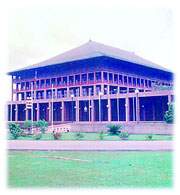
The Sri Jayawardanapura, Kotte, parliament has traditional forms of roofs and its design provides natural ventilation and shade. (Library picture)
Towards sustainable development - an overview
By Chitra Weddikkara, Department of Management, Construction and Building Sciences, University of Western Sydney, Hawkesbury, New South Wales, Australia
|
The Sri Jayawardanapura, Kotte, parliament has traditional forms of roofs and its design provides natural ventilation and shade. (Library picture) |
Copyright © 2001 Wijeya Newspapers Ltd. All rights reserved.
Webmaster Editorial